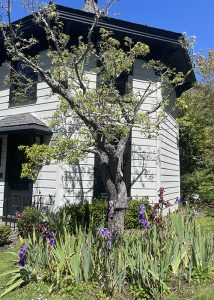 By Katherine Randolph, Marin Master Gardeners Pruning Guild
By Katherine Randolph, Marin Master Gardeners Pruning Guild
On March 25th, a large group of Japanese garden aficionados gathered at Marin Art and Garden Center to observe a demonstration of traditional Japanese pruning. With its foundation in Japanese garden design, bonsai and arboriculture, Japanese pruning incorporates visual art and design principles to work with plant material within its specific setting. The demonstration provided a unique opportunity for local professionals and enthusiasts to observe and interact with both Japanese garden professionals and American gardeners who have apprenticed in Japan.
The demonstration was led by Hiroaki Eto, a second-generation designer and builder of Japanese gardens in Southern Japan for over 40 years, and one of the most highly respected builders of tea gardens there. Eto-san is visiting with a small crew installing and renovating a few Japanese style gardens in the Bay Area. His crew included his son, Toshi Eto, and Makoto Shigematsu as well as a pair of Americans, Avram Dalton and Asher Browne, designers and builders of Japanese gardens in San Diego and New Jersey respectively, who have apprenticed in Japan. For the demonstration, Avram also served as translator.
As the Center’s gardens have been undergoing a slow but steady renovation under the leadership of Robert Mooney, Garden Manager, many of the plants have begun renewed growth. An old lace leaf maple, Acer palmatum dissectum, near the Moya Library is a tree that has benefited from Robert’s work. Eto-sans crew removed two lower limbs and some crossing branches, and opened up the crown to allow more light to the lower parts of the tree.
One of the guiding principles of aesthetic pruning is to weaken the strong parts of the tree and strengthen the weak parts. The top of a tree is usually the strongest part so it will often grow so much it shades out the bottom. Thinning the top allows light to reach the lower branches and keep them healthy.
In Japanese gardens, a designer or pruner will look at the balance of all the plants in an area of a garden and how they interact. So, in the area around the lace leaf, they also pruned a small Osmanthus or False Holly next to the maple and thinned the English Laurel behind it.
 They also worked on a large species maple also next to the Moya, thinning the top and taking out two trunks that were more horizontal in their growth, taking away from the upward movement of the rest of the tree.
They also worked on a large species maple also next to the Moya, thinning the top and taking out two trunks that were more horizontal in their growth, taking away from the upward movement of the rest of the tree.
An old Japanese Black pine, Pinus thunbergii, which had not been pruned for many years, was also worked on extensively. Again, they removed some of the lower branches which were hugging the ground. This revealed the sinuous trunk of the tree and highlighted the contrast between the Nebari, or flare of the trunk and roots at the base of the tree, and the crown. Temporary ties were installed to open the tree and allow light to reach the lower branches.
Lastly, they worked on a Deodar Cedar, Cedrus deodara, in a wooden planter next to the Moya. Again, the tree had been fairly small for years but has recently taken off. The crew first did some structural pruning, remove dysfunctional limbs, and then opened it up. The long-term goal would be to see if it can be trained across the path towards the fountain. Since Deodar Cedars usually grow to 60’ high and 30’ wide, this tree will require a strong hand to keep it from dominating the area.
The demonstration provided a unique opportunity for local professionals and enthusiasts to observe and interact with both Japanese garden professionals and American gardeners who have apprenticed in Japan. It was sponsored by the Aesthetic Pruners Association (APA) which is a non-profit organization which strives to expand awareness and appreciation of aesthetic pruning, and to stimulate the exchange of ideas which deepen personal understanding of the artistry of pruning. Aesthetic pruning provides a straight-forward and versatile method of addressing pruning issues. Its goal is to add harmony, interest and beauty to garden spaces through pruning. It emphasizes pruning with design intent and understanding the visual impact of pruning choices.
Joining members of the APA at the demo were members of Marin Master Gardeners Pruning Guild, which is in its sixth year. Members are taught by instructors from the Merritt Landscape Horticultures Aesthetic Pruning program. The purpose of the Guild is to develop a group of skilled and knowledgeable pruners who can educate the public on the culture and pruning of small trees, woody shrubs and vines. The Guild prunes in local school and community gardens in Marin, including MAGC.




